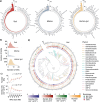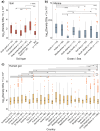The defensome of complex bacterial communities
- PMID: 38459056
- PMCID: PMC10924106
- DOI: 10.1038/s41467-024-46489-0
The defensome of complex bacterial communities
Abstract
Bacteria have developed various defense mechanisms to avoid infection and killing in response to the fast evolution and turnover of viruses and other genetic parasites. Such pan-immune system (defensome) encompasses a growing number of defense lines that include well-studied innate and adaptive systems such as restriction-modification, CRISPR-Cas and abortive infection, but also newly found ones whose mechanisms are still poorly understood. While the abundance and distribution of defense systems is well-known in complete and culturable genomes, there is a void in our understanding of their diversity and richness in complex microbial communities. Here we performed a large-scale in-depth analysis of the defensomes of 7759 high-quality bacterial population genomes reconstructed from soil, marine, and human gut environments. We observed a wide variation in the frequency and nature of the defensome among large phyla, which correlated with lifestyle, genome size, habitat, and geographic background. The defensome's genetic mobility, its clustering in defense islands, and genetic variability was found to be system-specific and shaped by the bacterial environment. Hence, our results provide a detailed picture of the multiple immune barriers present in environmentally distinct bacterial communities and set the stage for subsequent identification of novel and ingenious strategies of diversification among uncultivated microbes.
© 2024. The Author(s).
Conflict of interest statement
The authors declare no competing interests.
Figures






Similar articles
-
Extensive diversity and rapid turnover of phage defense repertoires in cheese-associated bacterial communities.Microbiome. 2022 Aug 27;10(1):137. doi: 10.1186/s40168-022-01328-6. Microbiome. 2022. PMID: 36028909 Free PMC article.
-
Covalent Modifications of the Bacteriophage Genome Confer a Degree of Resistance to Bacterial CRISPR Systems.J Virol. 2020 Nov 9;94(23):e01630-20. doi: 10.1128/JVI.01630-20. Print 2020 Nov 9. J Virol. 2020. PMID: 32938767 Free PMC article.
-
Insights from 20 years of bacterial genome sequencing.Funct Integr Genomics. 2015 Mar;15(2):141-61. doi: 10.1007/s10142-015-0433-4. Epub 2015 Feb 27. Funct Integr Genomics. 2015. PMID: 25722247 Free PMC article. Review.
-
Small and mighty: adaptation of superphylum Patescibacteria to groundwater environment drives their genome simplicity.Microbiome. 2020 Apr 6;8(1):51. doi: 10.1186/s40168-020-00825-w. Microbiome. 2020. PMID: 32252814 Free PMC article.
-
[Why so rare if so essentiel: the determinants of the sparse distribution of CRISPR-Cas systems in bacterial genomes].Biol Aujourdhui. 2017;211(4):255-264. doi: 10.1051/jbio/2018005. Epub 2018 Jun 29. Biol Aujourdhui. 2017. PMID: 29956652 Review. French.
Cited by
-
Distribution of specific prokaryotic immune systems correlates with host optimal growth temperature.NAR Genom Bioinform. 2024 Aug 20;6(3):lqae105. doi: 10.1093/nargab/lqae105. eCollection 2024 Sep. NAR Genom Bioinform. 2024. PMID: 39165676 Free PMC article.
-
Advancing RNA phage biology through meta-omics.Nucleic Acids Res. 2025 Apr 22;53(8):gkaf314. doi: 10.1093/nar/gkaf314. Nucleic Acids Res. 2025. PMID: 40263712 Free PMC article. Review.
-
Pipolins are bimodular platforms that maintain a reservoir of defense systems exchangeable with various bacterial genetic mobile elements.Nucleic Acids Res. 2024 Nov 11;52(20):12498-12516. doi: 10.1093/nar/gkae891. Nucleic Acids Res. 2024. PMID: 39404074 Free PMC article.
-
Long-term metagenomic insights into the roles of antiviral defense systems in stabilizing activated sludge bacterial communities.ISME J. 2025 Jan 2;19(1):wraf051. doi: 10.1093/ismejo/wraf051. ISME J. 2025. PMID: 40096540 Free PMC article.
-
Pseudomonas aeruginosa as a model bacterium in antiphage defense research.FEMS Microbiol Rev. 2025 Jan 14;49:fuaf014. doi: 10.1093/femsre/fuaf014. FEMS Microbiol Rev. 2025. PMID: 40240293 Free PMC article. Review.
References
MeSH terms
LinkOut - more resources
Full Text Sources

